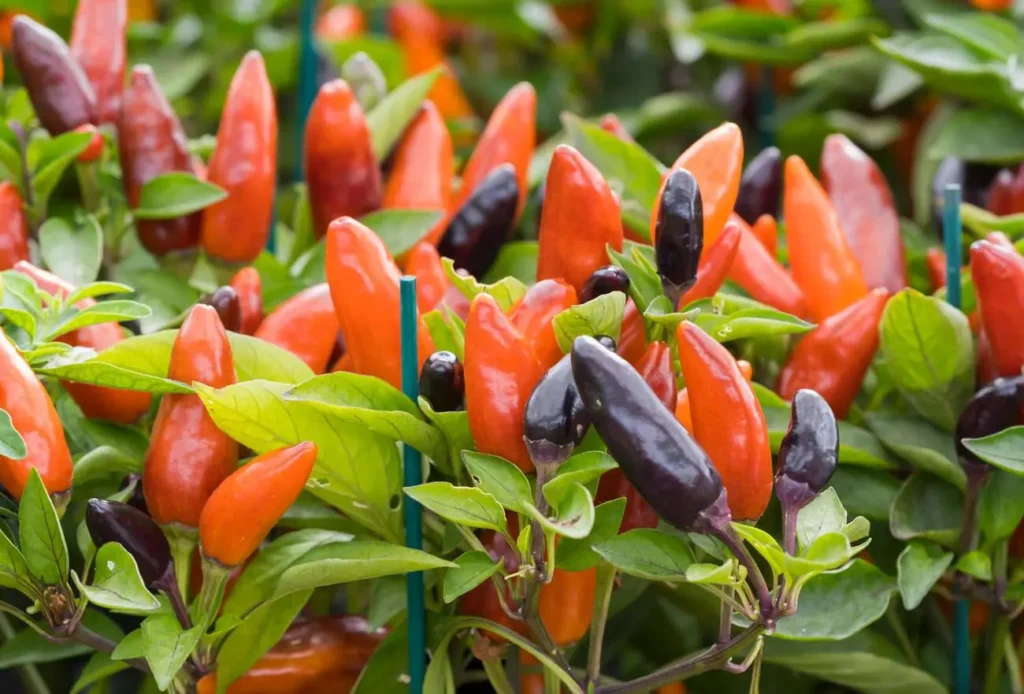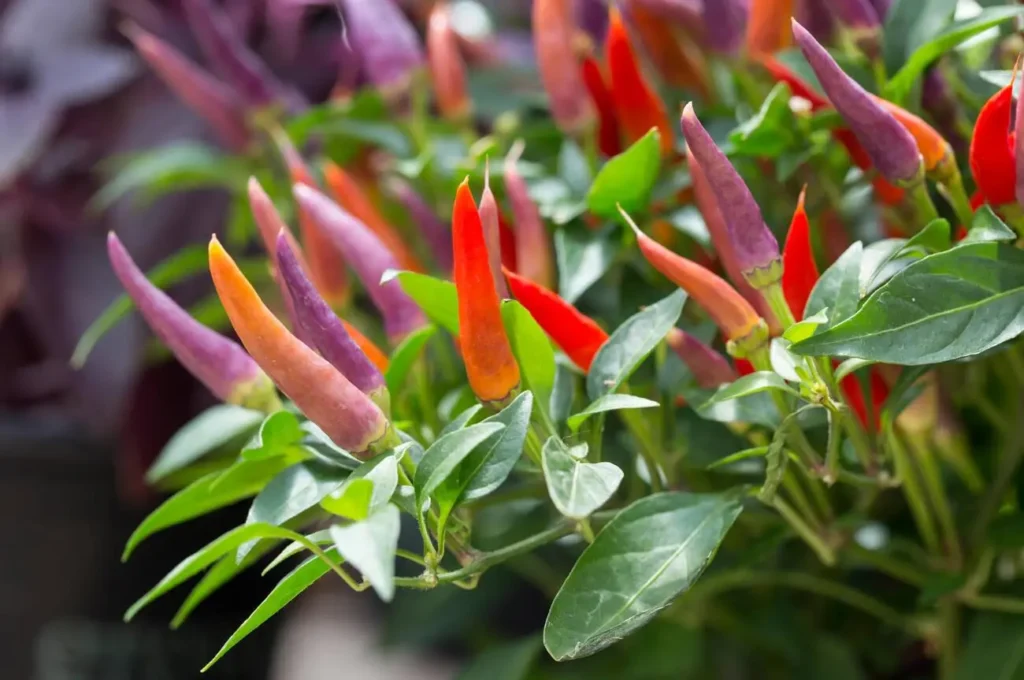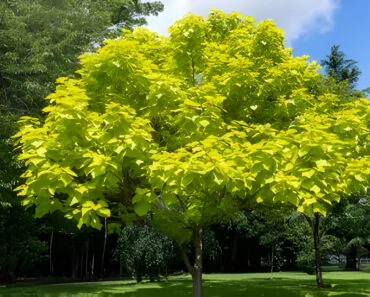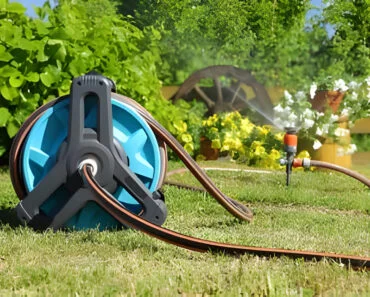
Are you looking to add some color and spice to your garden? Ornamental peppers might be just what you need!
In this article, we will explore everything you need to know about planting and growing these vibrant plants. From choosing the right variety to preparing the soil and caring for your peppers, we’ve got you covered.
If you’re ready to brighten up your garden with some beautiful ornamental peppers, keep reading to learn more!
What Are Ornamental Peppers?
Ornamental peppers are a type of plant that is grown for their attractive and colorful fruits, which can add a unique aesthetic to any garden or indoor space. These plants are not only visually appealing but also versatile, as they can be used for both decorative purposes and culinary applications, depending on the variety.
Their growth habits make them suitable for containers or garden beds, thriving in full sunlight and well-drained soil. To ensure proper care, ornamental peppers require regular watering and fertilization during the growing season. Pruning can help maintain a neat appearance and promote new growth. With their compact size and low maintenance needs, these peppers have gained popularity among gardeners seeking to enhance the visual appeal of their outdoor spaces.
Whether planted in clusters or as standalone specimens, ornamental peppers bring vibrancy and interest to any landscape.
How to Choose the Right Variety of Ornamental Pepper to Plant?
Selecting the appropriate variety of ornamental pepper to plant is crucial for a successful gardening experience. With a wide range of pepper varieties available, each with its unique characteristics and growth requirements, understanding the differences and selecting the right one based on your preferences and gardening goals is essential.
Consider the growth habits of the ornamental pepper you choose; some varieties are compact and suitable for containers, while others may grow larger and require more space in the garden. The color variations in ornamental peppers range from vibrant shades of red, orange, and yellow to more subtle hues like purple and black, allowing you to create visually striking displays. Understanding the intended use of the peppers, whether for culinary purposes or purely ornamental reasons, can also influence your selection. Taking into account these factors will help you care for your pepper plants and maximize their beauty in your garden.
What Are the Different Types of Ornamental Peppers?
Ornamental peppers come in a diverse array of types, ranging from edible varieties that offer a mix of flavor and visual appeal to purely decorative peppers that are primarily grown for their striking colors and ornamental value. Understanding the distinctions between these different types can help you make an informed decision when selecting the right ornamental pepper for your garden or indoor space.
Edible ornamental peppers, such as the Bolivian rainbow pepper and Numex Twilight, not only add a pop of color to your living space but also serve as a delightful addition to unique recipes.
On the other hand, decorative varieties like Black Pearl and Medusa offer an explosion of vibrant hues that can enhance the aesthetic charm of any garden setting. When strategically placed, these peppers can create visual interest and elevate the overall look of your landscape.
With their versatility in both culinary and ornamental aspects, ornamental peppers truly offer a delightful fusion of beauty and practicality.
What Are the Factors to Consider When Choosing an Ornamental Pepper?
When selecting ornamental peppers for planting, consider factors like sunlight, soil, and intended use (decorative or culinary) to ensure optimal growth. Understand your objectives, whether it’s adding color to garden beds, creating striking container displays, or enjoying unique foliage and fruit.
Different pepper varieties have different growth conditions, so choose one suitable for your climate and soil. Pay attention to maintenance needs like watering, pruning, and pest control for proper care.
When and Where to Plant Ornamental Peppers?
Determining the ideal time and location to plant ornamental peppers is crucial for their successful growth and development. Understanding the seasonal preferences, temperature requirements, and sunlight exposure needed by these plants can help create an optimal environment that promotes healthy growth and abundant fruit production.
When planning to plant ornamental peppers, it is advisable to aim for a time when the soil has warmed up and there is no longer a risk of frost, typically around late spring to early summer. The location for planting should offer well-drained soil with good air circulation and at least 6-8 hours of sunlight daily. Consider incorporating organic matter into the soil to improve fertility and ensure regular watering, especially during hot and dry periods. Maintenance practices like mulching can also help in retaining soil moisture and suppressing weeds, promoting overall plant health.
What Is the Best Time to Plant Ornamental Peppers?
Timing is crucial when planting ornamental peppers as it affects their growth and productivity. It’s best to plant them after the last frost date to avoid stunting growth or damaging foliage. Consider your local climate; ornamental peppers thrive in warm weather, so wait until spring is settled.
By waiting for mild temperatures, you give your peppers a chance to establish strong roots and produce colorful fruits. Be cautious of late frosts, as ornamental peppers don’t tolerate them well.
What Type of Soil is Best for Ornamental Peppers?
Choosing the right soil for ornamental peppers is essential to support their nutrient needs, water retention, and root development. Well-draining, fertile soil with a slightly acidic pH level is generally recommended for ornamental peppers to thrive and produce healthy foliage and fruits.
The soil composition should be lightweight to aid in proper aeration around the roots, preventing waterlogging and enhancing nutrient uptake. Ornamental peppers benefit from a nutrient-rich soil, so incorporating organic matter like compost or well-aged manure can provide essential nutrients for vigorous growth. Monitoring the pH of the soil is crucial, as ornamental peppers prefer a slightly acidic environment ranging between 6.0 to 6.5. Maintaining adequate levels of nitrogen, phosphorus, and potassium in the soil is also vital for promoting flowering and fruiting in these vibrant plants.
How Much Sunlight Do Ornamental Peppers Need?
Ornamental peppers thrive in locations with ample sunlight exposure, typically requiring at least 6-8 hours of direct sunlight daily for optimal growth and fruit production. Insufficient sunlight can lead to leggy growth, decreased fruiting, and overall plant stress, affecting the plant’s health and appearance.
Ornamental peppers need sufficient sunlight to avoid becoming spindly and to produce vibrant fruits. Adequate sunlight promotes sturdy stems, lush foliage, and intense pepper colors, enhancing their visual appeal. Providing the right amount of sunlight sets up ornamental pepper for success and helps them reach their full decorative potential.
How to Prepare the Soil for Planting Ornamental Peppers?

Preparing soil for planting ornamental peppers involves key steps to ensure it’s well-nourished, aerated, and conducive to root growth. Tasks like weed removal, adding organic matter, and testing soil pH create an optimal environment for healthy pepper growth.
- One important aspect of enriching the soil is to add compost or well-rotted manure, which not only provides essential nutrients but also improves soil structure.
- Mixing in perlite or vermiculite can enhance drainage and aeration, promoting root development.
- Adjusting the soil pH to the ideal range of 6.0 to 6.8 can boost nutrient availability for the peppers. Consider using an organic soil acidifier like sulfur or lime to achieve the desired pH level.
These steps combined can lay the foundation for successful ornamental pepper cultivation.
What Are the Steps for Preparing the Soil?
Preparing soil for ornamental pepper involves essential steps to create an optimal growing environment. Tasks like clearing the area, loosening soil, and adding organic matter enhance fertility and support root development.
- After these initial steps, consider conducting a soil test to determine the pH level and nutrient content of the soil.
- Based on the results, adjust the soil pH if needed using materials like agricultural lime for acidic soil or elemental sulfur for alkaline soil.
- Ensure proper drainage by amending the soil with compost or peat moss to improve water retention and aeration.
Remember to monitor soil moisture levels regularly and mulch around the base of the plants to suppress weeds and retain moisture, creating a favorable environment for ornamental peppers to thrive.
What Are the Recommended Fertilizers for Ornamental Peppers?
Choosing the right fertilizer for ornamental peppers is crucial for providing essential nutrients that support healthy growth and fruit production. Balanced fertilizers with a blend of nitrogen, phosphorus, and potassium, as well as micronutrients like magnesium and calcium, can help ensure that ornamental peppers receive the necessary nutrients for optimal performance.
Ornamental peppers benefit from secondary nutrients like sulfur, and micronutrients such as iron and zinc, in addition to macronutrients. These nutrients support various metabolic processes, leading to stronger stems, vibrant foliage, and abundant fruiting.
Using controlled-release fertilizers supplies nutrients steadily over time, reducing leaching risk and ensuring consistent uptake by plant roots. Understanding the nutrient needs of ornamental peppers helps choose the right fertilizer and application method for promoting plant health and maximizing fruit production.
How to Plant Ornamental Peppers?
- Planting ornamental peppers involves selecting seeds or seedlings, planting, watering, and transplanting. By following proper procedures and providing care, you can establish healthy pepper plants that produce vibrant fruits.
- To kickstart the process, choose high-quality seeds that are disease-resistant and suited to your local climate. Ensure seeds are sown in well-draining soil and kept consistently moist but not waterlogged. Lightly cover the seeds with a thin layer of soil, maintaining a warm and humid environment for germination.
- Once your seedlings emerge, cultivate a routine watering schedule, ensuring the soil remains evenly moist. As the plants grow, consider incorporating a balanced fertilizer to promote healthy growth and fruit production. When the seedlings have developed sturdy roots and several sets of leaves, it’s time to carefully transplant them into larger containers or outdoor garden beds.
What Are the Steps for Planting Ornamental Peppers?
The process of planting ornamental peppers involves several essential steps to ensure successful establishment and growth. Tasks such as seedling preparation, soil placement, watering, and monitoring are crucial for fostering healthy root development and robust plant growth throughout the growing season.
To start, when handling the seedlings, it’s important to gently remove them from their containers, being careful not to damage the delicate roots. Next, ensure the soil is well-draining and rich in organic matter, providing a healthy growing environment for the peppers. When planting, create holes in the soil that are deep enough to accommodate the root system of each seedling. Water the newly planted peppers thoroughly, allowing the soil to be evenly moist but not waterlogged. After planting, place the peppers in a sunny location and continue to monitor their growth and water them regularly to support healthy development.
How Far Apart Should Ornamental Peppers Be Planted?
Determining the right spacing for ornamental pepper is crucial for optimal growth, air circulation, and sunlight exposure. Adequate spacing prevents overcrowding, reduces disease risks, and promotes plant health.
Consider mature size and shape when placing peppers to avoid competition for resources. Companion planting with compatible herbs or flowers can offer pest protection and enhance growth.
Follow recommended spacing guidelines, typically 12-18 inches apart, to ensure strong root systems and abundant fruit production for each plant.
How to Care for Ornamental Peppers?
Caring for ornamental pepper involves consistent watering, fertilization, pest control, and maintenance. By following these practices and addressing issues promptly, you can ensure healthy plant growth and fruit production.
When it comes to watering ornamental peppers, it’s crucial to maintain a balance – they prefer well-drained soil and should not be overwatered. It’s recommended to water deeply but infrequently to encourage strong root development.
For fertilization, opt for a balanced, water-soluble fertilizer and apply it every few weeks during the growing season. Keep an eye out for potential pests like aphids or spider mites; utilizing natural remedies or insecticidal soaps can help manage these issues effectively.
Regularly inspect your plants for any signs of disease, such as leaf spots or wilting, and take necessary actions to prevent further spread. Don’t forget to prune your ornamental peppers to promote bushier growth and remove any dead or diseased parts that could compromise plant health.
What Are the Watering and Fertilizing Requirements for Ornamental Peppers?
Ornamental peppers have specific watering and fertilizing requirements that must be met to support their growth and fruiting. Providing consistent moisture levels, avoiding overwatering, and applying balanced fertilizers at the right times are crucial for ensuring that ornamental pepper receive the necessary nutrients for healthy development.
When watering ornamental peppers, it is essential to strike a balance between keeping the soil evenly moist but not waterlogged. Overwatering can lead to root rot, which can severely damage the plant. It is advisable to water deeply but infrequently, allowing the soil to dry out slightly between waterings to prevent issues with excess moisture.
Fertilizing ornamental peppers should be done using a balanced fertilizer with equal parts nitrogen, phosphorus, and potassium to promote overall plant health and encourage robust fruit production.
How to Prevent Pests and Diseases in Ornamental Peppers?
Preventing pests and diseases in ornamental pepper requires proactive measures such as regular inspections, proper sanitation, and timely intervention when issues arise.
By promoting plant health through cultural practices, natural remedies, and organic pest control methods, you can minimize the risk of pest infestations and disease outbreaks in your pepper plants.
Integrated pest management (IPM) techniques play a crucial role in pest and disease prevention for ornamental peppers. This approach employs a combination of biological controls, such as beneficial insects, and mechanical controls, like handpicking pests. Selecting disease-resistant pepper varieties can greatly reduce the susceptibility of your plants to common pathogens. Regularly monitoring your plants for early signs of trouble and promptly addressing any issues can prevent minor problems from escalating into major infestations or outbreaks.
When and How to Harvest Ornamental Peppers?
Knowing when and how to harvest ornamental peppers is essential to maximize flavor, color, and overall quality. Harvesting peppers at the right stage of ripeness, using proper tools, and storing them correctly can help preserve their taste and appearance, whether they are intended for culinary use or decorative purposes.
Ornamental peppers typically reach peak ripeness when they have fully developed their vibrant colors, such as red, orange, or purple hues. Gently squeezing the peppers to check for firmness can be a good indicator of readiness for harvest. When harvesting, it’s advisable to use sharp garden scissors or pruning shears to avoid damaging the plants. After picking, it’s important to handle the peppers with care to prevent bruising. Proper post-harvest practices include storing the peppers in a cool, dry place away from direct sunlight to maintain their freshness and extend their shelf life.





